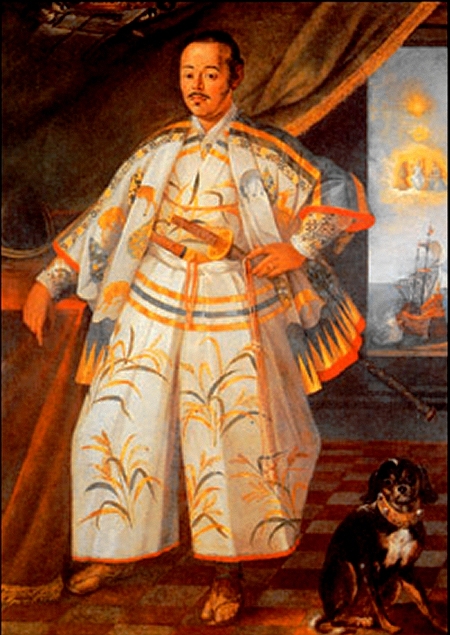The Voyage of Hasekura Tsunenaga (1613-1620) was
remarkable in its scope and vision standing in hard contrast to
the policies of the Tokugawa in their attempts to control the political
climate, foreign trade and impact of the outside world on Japan
in the early 17th Century. This journey wrote a remarkable chapter
in Japanese History.This voyage of a delegation of 180 men was begun
in 1613 at the time Jamestown the first
English Colony in America was just seven years old and struggling
to establish a foothold in Virginia. Hasekura's mission traveled
from Japan to Europe crossing both the Pacific and Atlanitc and
returned again to Japan arriving back in Japan in 1620, the same
year that Plymouth Colony was established
by a group of 140 Pilgrims coming to America from England by the
way of Holland.
This journey was the highwater mark in the use
of ships by the Japanese in the 17th century.
During the course of Hasekura's mission, back
in Japan in February of 1614, Tokugawa Hidetada had issued another
edict expelling Christian priests from Japan and this resulted
in a hardening of the Spanish attitude toward trade with Japan.
Hasekura had met his objectives and accomplished his mission however
because of the repression of Christian Missionaries was becoming
the political agenda of the Tokogawa, Hasekura failed to secure
open trade agreements with the west for Date Masamune. Thirty
of Hasekura's delegates remained in Spain knowing that by returning
to Japan they would be persecuted as Christians.
The Japanese mission was the topic of much discussion
within the Jesuits circle in Rome and the motives for sending
this mission to Rome was hotly debated in view of what the church
understood the current policies of the Tokugawa to be. The politcal
climate in Japan and the recent restrictions made by the Tokugawa
against Christian missionaries was well known and success of the
mission was compromised by the differences between the statements
made by Date Masumune and the hard line taken by the Tokugawa
against foreign missionaries. It was clear that although Masumune
had sent his trade delegation to Rome that back in Japan Date
ruled at the discretion and favor of the Tokugawa and that it
was the policies of the Tokugawa that the Church had to be most
concerned with.
Hasekura Tsunenaga and his remaining delegates
made the return trip home to Japan making a stop over in the Philippines.
The delegation remained in the Philippines, another important
Japanese trading colony, and after two years in the Philippines
Hasekura returned to Japan in September 1620. Despite the fact
that this mission had been received favorably, and there was great
European interest in Japan, Date Masamune was forced to abandoned
his efforts at diplomacy and trade with the west after the political
agenda of the Tokugawa Shogunate banned Christianity in Japan
and began to severely limit and control Japan's contact with the
rest of the world. Date Masamune's focus would shift from foreign
diplomacy to saving his own political career in Japan where he
would have to again prove his loyalty to the Tokogawa despite
the evidence of his pro western leanings.

Hasekura's portrait done during his mission
in Rome in 1615 by Claude Deruet
The differences between the outlooks of the
two leaders can noted in the letters of Tokugawa Ieyasu and Date
Masamune. In Ieyasu's letter to Pope Paul V he stated "I
don't mind if you take advantage of coming to Japan to make a
profit but don't spread Christianity." On the other hand,
Date's letter said "I'll offer my land for a base of your
missionary work. Send us as many padres as possible."

Ship Detail from Hasekura Painting
Because of their different outlooks on trade
with the west and the desirability of having Christian missionaries
in Japan Date Masamune would come under suspicion of plotting
to overthrow the Tokugawa and the political climate in Date's
provinces would require him to prove again his loyalty to the
Tokugawa. The Tokugawa judged to a large degree the extent of
this loyalty on how Date dealt with the known Christian subjects
within his domain.
After Ieaysu's death the task would fall to Date
Masumune to finance the building his mortuary temple. This undertaking
would drain his financial coffers and allow the Shogunate to keep
his political allegiance to the Tokugawa under constant scrutiny.
After Hasekura's return Christain activities in Japan would be
severly curtailed by the Tokugawa.
To learn more of this epic adventure read Shusaku
Endo's historical novel "Samurai".
Hasekura Tsunenaga's , mission would be the one
and only journey of its kind using ships in the 17th century in
Japanese History.
